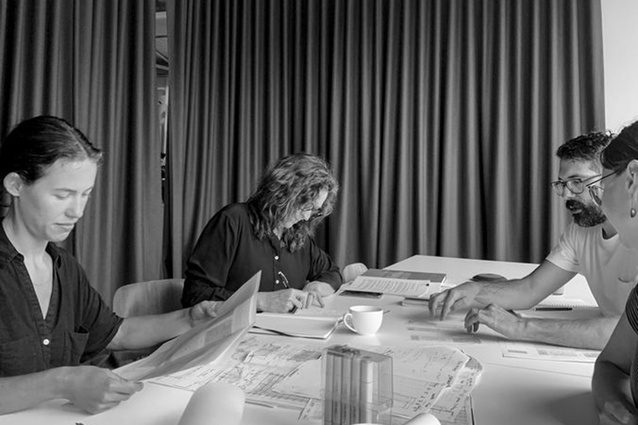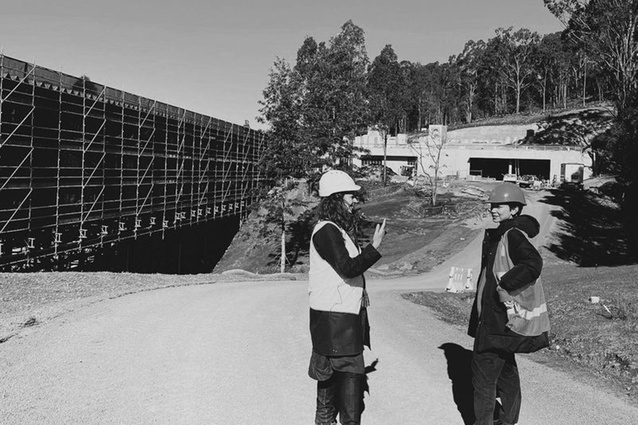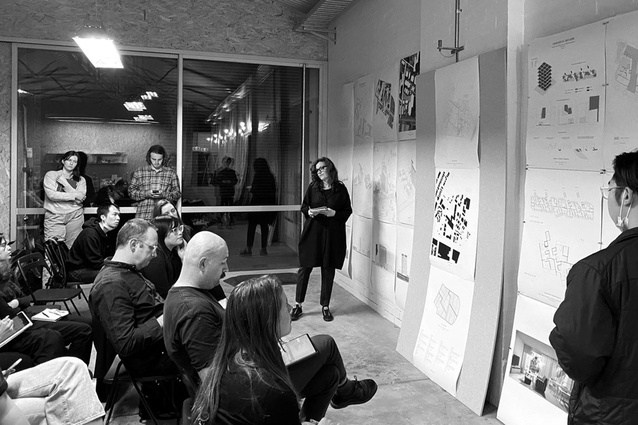AIA 2023 Gold Medallist Kerstin Thompson: Negotiating the in-between
Just as Kerstin Thompson Architects’ built projects revolve around interstitial spaces, Thompson’s cultural contributions have influenced “the grey zones of invention and possibility,” countering myths and opening up spaces for discussion. Parlour co-founder Justine Clark takes a closer look at Australian Institute of Architects 2023 Gold Medallist Kerstin Thompson’s practice.
Early in 2001, Kerstin Thompson presented the work of Kerstin Thompson Architects (KTA) at a public lecture at the University of Melbourne under the title “Gradient architectures.” She spoke eloquently of the practice’s interest in the in-between and the interstitial; of “building the moments between opposites”; of incremental change, visible seams and stepped calibration; of an architecture “activated through occupation.”
Recently arrived in Australia, I sat in that darkened theatre, entranced. The glowing images showed a compelling body of work, but what really captured my attention was the rigour and care of the discussion. This framed the work, seeping into and around the projects shown and promising much more. This was not theory twisted out of shape to justify form-making. Here was the post-structuralism that had informed the architectural education of our generation used intelligently to underpin strategies for architectural thinking and acting, and ways of being in the world.
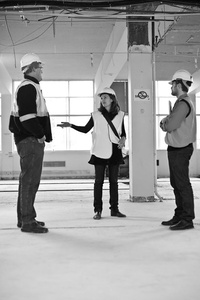
As the new assistant editor at Architecture Australia, I asked Kerstin if we could publish the talk — and convinced my boss that it was important.¹ Over the following decades, I have watched her career flourish. I have enjoyed thoughtful conversations about work and practice, and I have observed and benefited from her generous contribution to architecture’s public and professional cultures.
Kerstin has continued the commitment to the interstitial, cultivating the messy, uncertain and fascinating spaces between and beyond binary opposites. This has proved to be incredibly fertile ground. These days, Kerstin is more likely to talk of “grey zones” and “spectrums of change” than gradients, but the clarity of thought and strategic framework that held so much promise have been realized in a rich body of work — built projects, speculative schemes, modes of practice and education, events, exhibitions, talks, writing and advocacy in the public and professional realms.
Kerstin’s work is distinguished by an interest in strategy and typology, combined with a fascination with everyday habits and happenings. There is a desire to create places that are both transformed and brought to life by those who inhabit them. In design terms, the interest in the in-between manifests in the exploration of interval buildings, in loose residential plans, in works that entwine building and landscape, in spaces that are at once public and private, in projects that embed the significance of heritage within the “informality of the everyday” — to name just a few.
On the occasion of the Gold Medal, others are also writing about KTA’s design work and built projects. I have been invited to reflect on Kerstin’s extensive contribution to architectural culture. It is worth noting, however, that these worlds are not discrete. They also inhabit a continuum. Design work, advocacy and cultural contributions overlap, intersect and entwine. Each draws on and informs the others; all are undertaken with intellectual curiosity and rigour.
Kerstin’s professional advocacy and cultural contribution are also characterized by an awareness of the constrictions of binary thinking and an exploration of the grey zones as places of invention and possibility. Part of this involves countering the myths that have long structured architecture. At the core of these is the hoary old heroic genius model of architectural practice, replete with arrogance and delusions of grandeur, poor communication, long hours and miserable underlings. This is, of course, the subject of decades of critique, but it is remarkably persistent — and underwrites the tedious cliché that high-quality design is incompatible with good business practices.
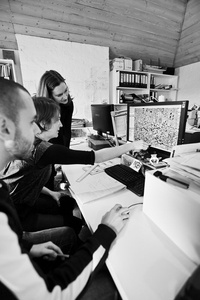
Kerstin has no time for these old myths, recognizing that they are at the heart of many of the current problems of the profession. They are also boring. There is no new insight to be found here, no space for invention, no joy. Sometimes she tackles these myths overtly — as in her 2019 address to the Association of Consulting Architects (ACA), “The business of design.” She declared: “We maintain that the quality of this design practice is indelibly linked to quality of business practice, health of workplace, thriving people and business. The way we do architecture as business and process can and should be as high quality as the much applauded, awarded and enjoyed output itself.”² More often, she circumvents the myths, taking us to more interesting territory, generously sharing experiences and knowledge, and making space for others to do likewise.
“The way we do architecture as business and process can and should be as high quality as the much applauded, awarded and enjoyed output itself.”
Kerstin has spoken often about the decision to establish her own practice, and the fact that this was driven in part by a desire to find ways to produce outstanding work that was not predicated on working absurd hours. This has been an ongoing project, and KTA has adapted over time as circumstances have changed and in response to experiences gained. When I first met Kerstin two decades ago, she was experimenting with “builders’ hours” — starting early, in the quiet before the phones started ringing, and finishing in time to be available for her young child after school.
By 2019, when she presented “The business of architecture,” KTA was a team of 30. Speaking of the value of design, Kerstin spoke of the importance of a clear, shared understanding of design intent, accessible to and embraced by all involved in the project. This enables timely decision-making and dispersed responsibility, and it aligns design quality with financial matters. Importantly, this notion of intent also allows space for negotiation — the delicate balance of adapting to changing circumstances while maintaining the project’s core attributes, without which the value offered through the design would be diminished.
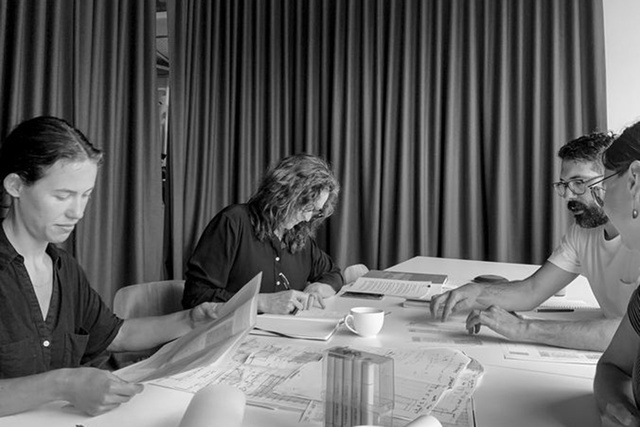
Publicly sharing such internal processes — including acknowledging that they are not always smooth or easy — is an important form of advocacy within the profession. It opens up space for discussion about aspects that too often go unmentioned. It reminds us that the habits of practice are part of the culture of the profession. They are not a-historical or a-theoretical (indeed, the KTA approach to design intent sounds rather similar to that pursued by John Andrews International, decades earlier). They can — and should — also be a space of invention and consideration. The myths can be renegotiated and remade.
Advocacy of this type occurs through public talks and writing, but also in the ways the practice chooses to present itself to the broader public. For example, the KTA contribution to the 2009 exhibition Portraits + Architecture, at the National Portrait Gallery, presented images of the practice in action. On site, in the office, architecture was shown as a place of work, encounter and exchange.
In that talk to the ACA, Kerstin also pointed out that good design is, itself, a form of advocacy. But she knows that it is naïve to imagine that the quality of the work speaks for itself; communicating the value of design and the contribution it makes is essential. Kerstin is an articulate and compelling speaker. She uses language carefully, with skill and beauty. She invites her audience in, locating ideas and framing projects in ways that are sophisticated, accessible and meaningful to those listening. She explains project drivers (bringing us back to that idea of project intent), not her wishes or her will. She also recognizes that public talks are just one way to demonstrate the value of design. How one conducts oneself in more ordinary contexts is equally or perhaps more important — “everyday presentations to our clients, authorities, planners and so on are also forums for challenging and changing the terms, the outcome, the context, expectations of architecture as advocacy for improved design outcomes.”³
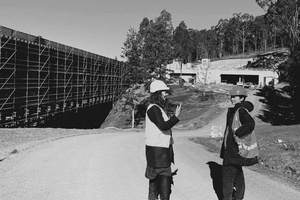
“Everyday presentations to our clients, authorities, planners and so on are also forums for challenging and changing the terms, the outcome, the context, expectations of architecture as advocacy for improved design outcomes.”
Most importantly, it is essential to stand up and speak out. The commitment to the in-between, to negotiation and accommodation, should not be confused with dithering or acquiescence: “So when a contract, competition or regulation strikes you as unfair, unreason-able, not in the interests of our profession and more broadly the public or civic interest, then speak up, agitate, reject and negotiate for a better outcome.” Kerstin is not afraid to say what she thinks.
Opening up space for discussion among others is also an important aspect of Kerstin’s contribution. In 2005, she was creative director of the Australian Institute of Architects’ national conference, themed “Exchange”. To my mind, this remains one of the most successful conferences to date, due in large part to the highly considered framing that balanced clarity of intent with the serendipity of the moment.
Speakers were carefully briefed, with session themes posed as questions, then invited to participate within a structure that promoted conversation, not pontification or posturing. As Kerstin reflected after the conference: “By placing this informal exchange between peers in the foreground, the audience was able to enjoy the vicarious pleasure of watching the unexpected unfold. We experienced the excitement and associated anticipation of the unpredictable, spontaneous and sometimes wayward tangents and trajectories that the most interesting and compelling conversation inevitably takes.”4
Kerstin’s work as an educator runs throughout her career. She began teaching at RMIT in 1990 and credits this as providing the context for examining what it means to be a critical or reflective practitioner. Her teaching is a further challenge to those old mythologies as she seeks to shift emphasis from the architect as sole author to a “much more negotiated practice,” as she explained in an interview in 2016. “The point … was to teach an appreciation for non-static context, which I think is in every way what practice is like every day. It’s contingent, you’re constantly getting thrown curve balls, and it’s how you negotiate and manage that and what you can extract out of it. I think that’s how good buildings come about. That’s a very valuable skill to have.”5
Teaching is also a way to focus the attention of future generations on the topics that matter. As a professor at Victoria University of Wellington, she set an agenda around housing, encouraging a strategic approach that helped equip students with the knowledge and skills to advocate for and tackle higher-density housing — a commitment that is also manifest in her own built work, competition entries and public advocacy.

All of this engagement beyond the office is a generous contribution to professional and public culture, but it is also imbricated with the world of the practice. Kerstin describes these contributions as a way to make space for thinking beyond the “cut and thrust” of the project, a chance to “step outside and see the wood for the trees.” These activities help make space for the development of ideas that then reverberate between these various worlds. Negotiating these many and varied in-betweens is a means to grasp the richness and complexity that our profession has to offer, and to contribute with rigour and intelligence.
Lastly, I want to acknowledge one more piece of messy, complicated territory that Kerstin navigates with aplomb: that of gender. For a long time, she was one of the few women in Australian architecture running a practice with her name on the door. Like almost everyone, Kerstin wishes to be recognized for the quality of her work and the value of her contribution, not the fact of her gender. Nonetheless, she understands that gender-based assumptions suffuse society, including “the language and concepts that frame and describe architecture.” These have the potential to impact the reception of work, the attitudes of clients and consultants, the expectations placed on professionals and the roles available to them, the assumptions about who does the “caring” work within practices and the profession, and the ease with which people attain and assume positions of authority.
“These [gender-based assumptions] have the potential to impact the reception of work, the attitudes of clients and consultants, the expectations placed on professionals and the roles available to them, the assumptions about who does the “caring” work within practices and the profession, and the ease with which people attain and assume positions of authority.”
In sharing practical strategies, Kerstin returns again to the post-structuralist rethinking of binary oppositions.6 This is, of course, a feminist approach, learned from Liz Grosz, the great Australian cultural theorist with whom Kerstin was lucky enough to study in the late Eighties. Kerstin describes this early training as providing “the beginning of a language for thinking about architecture and space that released me from some of the things that I struggled with in discussions around buildings and how they are imagined and revered and feared.”7 The development of Kerstin’s career is a remarkable fulfilment of this potential, revealing the power and promise of sophisticated feminist practices in the hands of an intelligent, rigorous and talented architect.
“Negotiating the in-between” is part of a series of essays commissioned to celebrate the Australian Institute of Architects 2023 Gold Medallist, Kerstin Thompson.
Read the whole series here.
This article first appeared in ArchitectureAU on 15 August, 2023.

REFERENCES
1 Kerstin Thompson, “Gradient architectures,” Architecture Australia , vol. 90, no. 3, May/Jun 2001, 66–71.
2 Kerstin Thompson, “The business of design,” based on a presentation to the Association of Consulting Architects – South Australia on 27 August 2019, available at aca.org.au/the-business-of-design.
3 Kerstin Thompson, “The business of design,” 2019.
4 Kerstin Thompson, “Exchanges,” Architecture Australia , vol. 94, no. 4, Jul/Aug 2005, 83–96, architectureau.com/articles/exchanges.
5 Kerstin Thompson, “Negotiating form: Q+A with Kerstin Thompson (Part 2),” interview by Michael Smith and Sonia Sarangi, The Red and Black Architect, 13 November 2016, theredandblackarchitect.wordpress.com/2016/11/13/negotiating-form-qa-with-kerstin-thompson-part-2.
6 Kerstin Thompson, “10 lessons,” Parlour, 14 March 2014, parlour.org.au/workplace/career-paths/10-lessons. This is an edited version of a talk presented at the 2013 Diverse Practice Symposium at Victoria University of Wellington.
7 Kerstin Thompson and Marie-Louise Richards [in conversation], “The profession through a feminist lens,” Parlour, 15 November 2021, parlour.org.au/parlour-reading-room/the-profession-through-a-feminist-lens.


